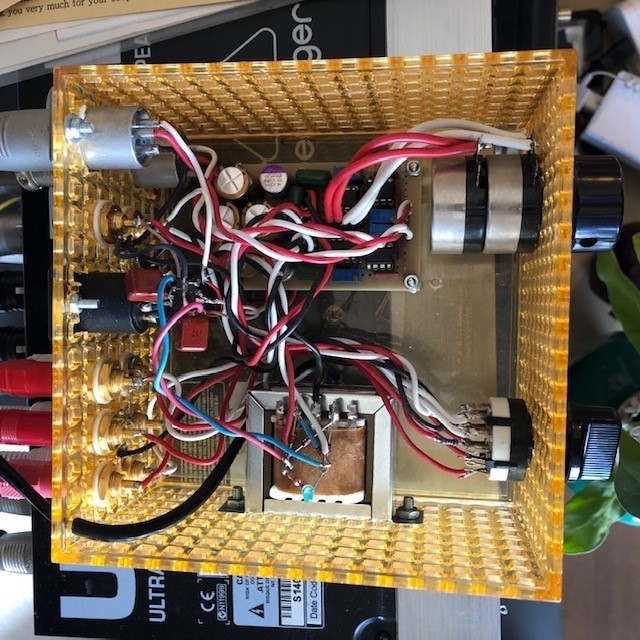Behringer DCX2496 Project
I start working on Behringer DCX2496 project and I decide to post my experience for future.
I have a very old pair of Martin Logan Ascent speakers. They are old but still makes great sound except that electro-static unit above 280Hz loosing sound level gradually, while low frequency unit is just fine.
It is possible to fix it by replacing electro-static panel or wash the panel; experienced Martin Logan user washes it.
but it seemed extremely hard to back it work again for me.
My simple solution was so-called bi-amplifier. I make up a barrack pre amplifier with 2 output per channel with gain adjustment for each. I added Sony TAN-330ES for Low frequency to a Mark Levinson No.331. I used white-noise source and free spectrum analyzer to adjust level of each cannel. In addition to adjust Low/High frequencies, Left/Light level required to be adjusted.
I could feel obvious improvement and had enjoyed the configuration without trouble for a while.

Picture: 3 input, 2 output with gain control preamplifier
The bad things are, its completeness as you can see, and the complex analog circuit that is substantially degrades sound quality. In addtion to that, the sound somewhat fuzzy by unknown reason.
Last year(2020), I added Behringer UltraDrive Pro DCX2496 speaker management system as an improvement project. I have adjusted DCX2496 with software tools provided, measurement microphone, and free spectrum analyzer. There is obvious improvement over bi-amp configuration, fuzzy sound gets some improvement.
However, I noticed that DCX2496 lacked output fader. I was expecting that I could have connected digital source directly to DCX2496 digital input. But, lack of fader means there is no method to control output level. If there were 4 channel balanced fader available, I could just get and connect fader between DCX2496 and power amplifiers.
Thus, analog output of digital source is connected to barrack preamplifier just for level control, then A/D converted in DCX2496. The barrack preamplifier still sits there just for level control.
Thus, I started this project for:
1. skip unnecessary DA/AD conversions,
2. simplify analog signal path,
3. skip DCX2469's analog circuit, said to be noisy.
The goals are:
1. DCX2496's modification to digital output,
2. To simplify analog signal path,
3. To learn how to use PIC (or RaspberryPi pico)
The plan includes:
1. multiple digital (SPDIF, I2S) inputs and capability to select source,
2. modification of DCX2496 to I2S outputs,
3. 2 of I2S input 2 channel Digital to Analog converter + power amplifier with fader,
4. (optional) analog inputs for tuner or other analog output devices,
5. use of PIC or RaspberryPi pico to control the system,
6. (optional) remote control.
as of Feb/17/2021, the project is under way.
ベリンガー DCX2496のプロジェクトをはじめたので、忘備録として記録します。
随分古いマーチンローガンのアセント(Ascent)を使っています。音はいいのですが、古くなるに従って、280Hz より上のコンデンサースピーカーの音が小さくなってきました。ユニットを交換するか、スピーカーユニットを外して洗うなどすればよいのですが、復旧できる自信はありません。
そこで、バイアンプを導入することにしました。
チャンネルごとに、2組のゲインを調整できるアンプを組み上げ、マークレビンソンのNo.331に加えて、低音用にソニーのTAN-330ESを追加しました。
ホワイトノイズと無料のスペクトルアナライザーを使い、低音/高音のレベルを調整しました。左右のレベルも差があったので、併せて調整しました。
結果、目論見通りの結果で、トラブルもなく、そのまま暫く使っていました。
ところが、原因はわからないのですが、音もなんとなくハッキリしないのが気になるようになりました。
昨年(2020), ベリンガーのUltraDrive Pro DCX2496スピーカーマネジメントシステムを追加することにしました。ベリンガーのソフトとマイク、フリーのスペクトルアナライザーで調整しました。バイアンプに比べるとだいぶ良く、音もクリアになりました。
ところが、DCX2496にはボリュームが付いていないことに気が付きました。デジタルの機器から直接DCX2496のデジタル入力に接続できると考えていたのですが、音量調節ができません。DCX2496とパワーアンプの間にボリュームを入れられればよかったのですが、バランス接続の4チャンネルのフェーダーなんてありません。
やむを得ず、音量調節のためだけに、デジタルの機器のアナログ出力とDCX2496のアナログ入力の間に挟む形になりました。
そこで、無駄なDA/AD変換をスキップし、アナログの信号パスを整理し、雑音が多いと言われているDCX2496のアナログ回路もスキップするために、このプロジェクトをはじめました。
目標は、DCX2496のデジタル出力改造、アナログ信号パスの簡素化と、PICの学習です。
計画では、なんチャンネルかのディジタル入力(SPDIF, I2S)の切り替え、DCX2496のI2S出力化、2チャンネルのI2S入力のボリューム付きDAC+パワーアンプ、チューナー用のADC(おまけ)、システムを制御するためのPIC(またはRaspberryPi pico)、できればリモコンもつけたいと思っています。
2021年2月17日現在、進行中です。